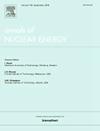Stability and bifurcation analysis of a Sodium-cooled Fast Reactor under two-phase flow using 1D multiphysics model
IF 1.9
3区 工程技术
Q1 NUCLEAR SCIENCE & TECHNOLOGY
引用次数: 0
Abstract
The Generation IV Sodium-cooled Fast Reactor (SFR) R&D program of the CEA (French Alternative Energies and Atomic Energy Commission), embodied in France by the ASTRID program (600 MWe, 2010–2019), must meet more stringent safety requirements than previous programs. For this reason, the behavior of the reactor in accident phenomenology is studied. We can distinguish three main initiator families that can lead to severe accident conditions in an SFR core: reactivity insertions, local subassembly failures and loss of primary flow. They can evolve in different ways depending on the transient and the reactor characteristics, especially the latter (boiling stabilization, primary power excursion). In order to assess the accidental behavior of innovative SFRs, in particular in case of sodium boiling, dedicated tools have been developed at CEA in recent years. In general, these tools are based on “fine” 3D codes that have highlighted the possibility of stabilized boiling. However, it is difficult to analyze stability with such tools in a dynamic scenario and it is also very complicated to validate complex numerical tools on a dynamic nonlinear phenomenology. In this paper, we propose a methodology that allows to study the stability of SFR nuclear cores under boiling conditions resulting from an unprotected loss-of-coolant accident. This methodology relies on a semi-analytical approach directly applied on a discretized model with possibly thousands of unknowns, rather than on a handful of unknowns derived from a reduced-order model as usually done in the literature when it comes to stability analyses. The nuclear reactor is modeled by a 1D drift thermal-hydraulic model, a 1D neutron diffusion model, and a OD heat transfer model. The semi-analytical methodology developed in this article is based on a continuation method, the Numerical Asymptotic Method, which allows us to compute all the stationary solutions of interest (single-phase liquid, two-phase) with good numerical efficiency (accuracy and computational time). We then perform a linear stability analysis of some of these stationary solutions, which amounts to solving generalized eigenvalue problems with a singular mass matrix. This allows us to study the effect of neutron coupling on the stability of steady-state solutions in the framework of Dynamical Systems Theory through bifurcation diagrams. We can see that neutron coupling extends the stability zone in the studied situation.
求助全文
约1分钟内获得全文
求助全文
来源期刊

Annals of Nuclear Energy
工程技术-核科学技术
CiteScore
4.30
自引率
21.10%
发文量
632
审稿时长
7.3 months
期刊介绍:
Annals of Nuclear Energy provides an international medium for the communication of original research, ideas and developments in all areas of the field of nuclear energy science and technology. Its scope embraces nuclear fuel reserves, fuel cycles and cost, materials, processing, system and component technology (fission only), design and optimization, direct conversion of nuclear energy sources, environmental control, reactor physics, heat transfer and fluid dynamics, structural analysis, fuel management, future developments, nuclear fuel and safety, nuclear aerosol, neutron physics, computer technology (both software and hardware), risk assessment, radioactive waste disposal and reactor thermal hydraulics. Papers submitted to Annals need to demonstrate a clear link to nuclear power generation/nuclear engineering. Papers which deal with pure nuclear physics, pure health physics, imaging, or attenuation and shielding properties of concretes and various geological materials are not within the scope of the journal. Also, papers that deal with policy or economics are not within the scope of the journal.
 求助内容:
求助内容: 应助结果提醒方式:
应助结果提醒方式:


